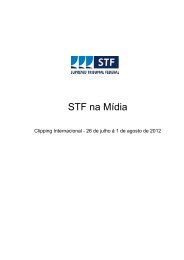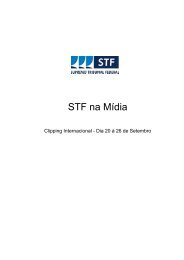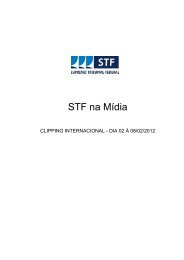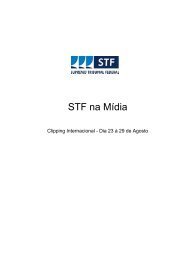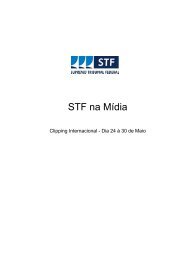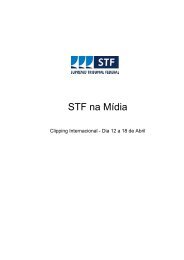10/05/2012 - Myclipp
10/05/2012 - Myclipp
10/05/2012 - Myclipp
Create successful ePaper yourself
Turn your PDF publications into a flip-book with our unique Google optimized e-Paper software.
USA Today/ - News, Seg, 14 de Maio de <strong>2012</strong><br />
CLIPPING INTERNACIONAL (Supreme Court)<br />
Editorial: Veterans are not 'dollar signs in<br />
uniform'<br />
The 1944 GI bill helped catapult a generation of<br />
veterans into the middle class and beyond, financing<br />
the education of three future Supreme Court justices,<br />
three presidents and thousands of doctors and<br />
scientists while democratizing many of the nation's<br />
leading universities.<br />
OPPOSING VIEW: Private colleges play a central role<br />
In 2008, Congress, figuring what worked once would<br />
work again, passed an expanded law that promised<br />
the same opportunity to the new generation of<br />
veterans who had served since 9/11.<br />
But some of those GIs are seeing their opportunity<br />
squandered by for-profit colleges with low graduation<br />
rates, high costs and high loan default rates. In fact,<br />
their new benefits might be propping up some schools<br />
that otherwise would struggle to meet federal rules.<br />
The failings of many for-profits — and the risks they<br />
pose for both students and taxpayers — have been<br />
widely publicized.<br />
The average cost for tuition and fees at for-profits is<br />
$14,487, 76% higher than the price that the average<br />
in-state student pays to attend a public institution. Yet<br />
by just about every academic measure, the for-profits<br />
deliver results inferior to those at traditional schools.<br />
Rate the debate<br />
At public universities that accept virtually all applicants,<br />
31% of the students graduate within six years. The<br />
rate is nothing to brag about, but it beats the for-profits,<br />
where just 22% graduate. Students also withdraw at<br />
far higher rates —more than 50% at six of the schools<br />
most popular with veterans. Loan default rates are<br />
higher, an indication that students aren't faring well.<br />
Still, veterans are flocking to the for-profits. Among the<br />
top <strong>10</strong> recipients of GI educational dollars in the<br />
20<strong>10</strong>-11 school year were eight companies that run<br />
for-profit schools, led by Apollo, parent of the<br />
University of Phoenix. Why so popular? Online<br />
courses, flexible hours and, in some cases, an<br />
effective education.<br />
Many schools also aggressively mine the lucrative<br />
veterans market. Veterans look like \"dollar signs in<br />
uniforms\" to predatory schools, Theodore Daywalt,<br />
CEO of VetJobs, told a Senate hearing last year. The<br />
reason? A loophole in a federal law meant to ensure<br />
that for-profit schools are solid enough to attract some<br />
students who pay their own way.<br />
USATODAY OPINION<br />
About Editorials/Debate<br />
Opinions expressed in USA TODAY's editorials are<br />
decided by its Editorial Board, a demographically and<br />
ideologically diverse group that is separate from USA<br />
TODAY's news staff.<br />
Most editorials are accompanied by an opposing view<br />
— a unique USA TODAY feature that allows readers to<br />
reach conclusions based on both sides of an argument<br />
rather than just the Editorial Board's point of view.<br />
These schools are required to get at least <strong>10</strong>% of their<br />
revenue from sources other than federal student<br />
grants and loans. The idea is sound. But in a bizarre<br />
twist, veterans benefits do not count as federal funds<br />
and can be used to plump up the non-federal <strong>10</strong>%.<br />
The for-profits' trade association says many schools<br />
surpass the <strong>10</strong>% threshold, but tellingly, it opposes<br />
raising the level to 15%.<br />
Some schools also stretch the truth or worse. Thirteen<br />
of 15 colleges investigated by the Government<br />
Accountability Office gave agents posing as applicants<br />
questionable, even deceptive, pitches about<br />
graduation rates, guaranteed jobs or likely earnings.<br />
This is a shoddy way to treat any student, and it's a<br />
dubious way to invest taxpayer money. It's just all the<br />
more offensive when applied to veterans. As Sen. Tom<br />
Harkin, D-Iowa, says, the GI benefit is a life-changing<br />
\"one-time shot.\"<br />
His legislation to plug the <strong>10</strong>% loophole is a sensible<br />
response. But until for-profits improve or student aid<br />
rules are overhauled, veterans will need to look out for<br />
themselves.<br />
250



